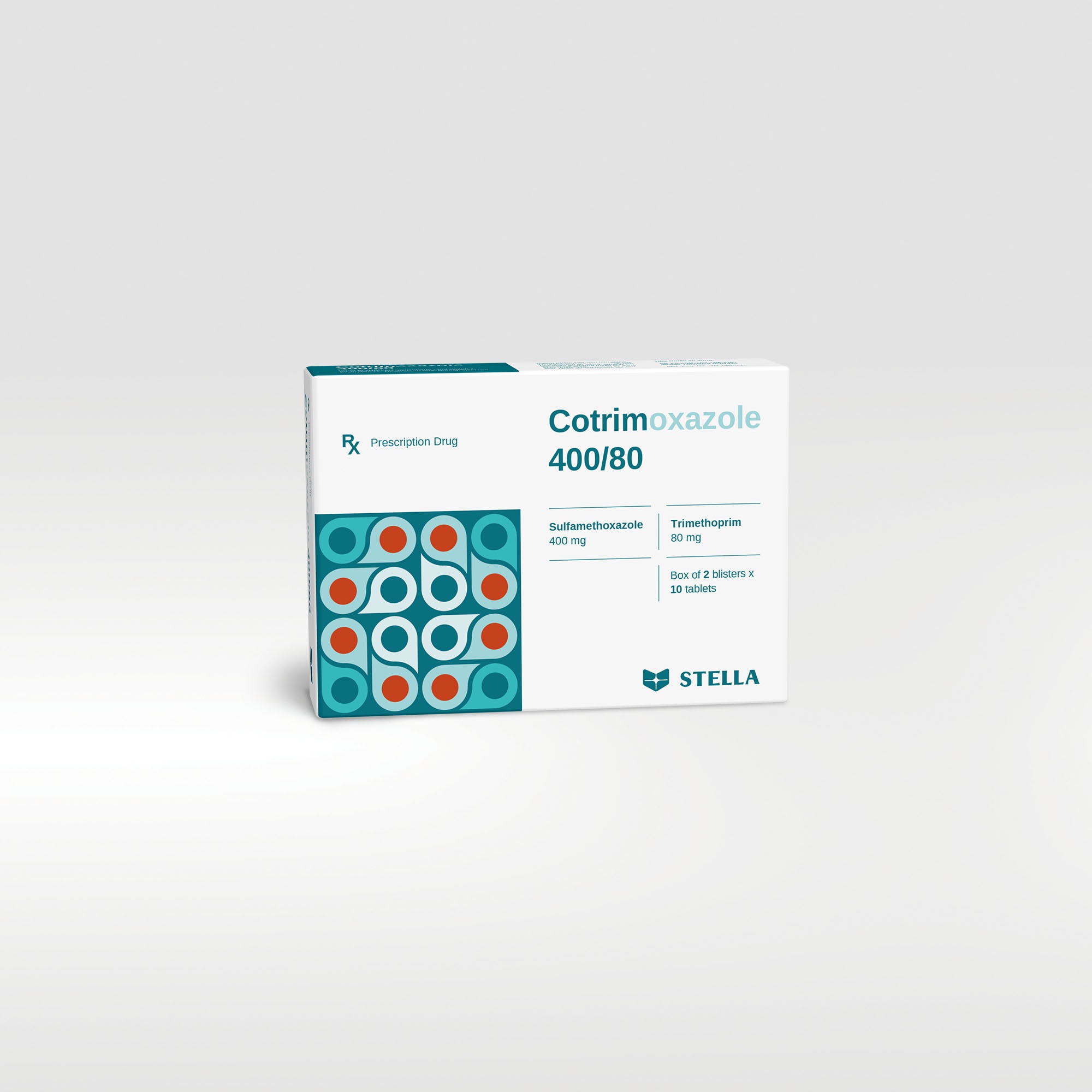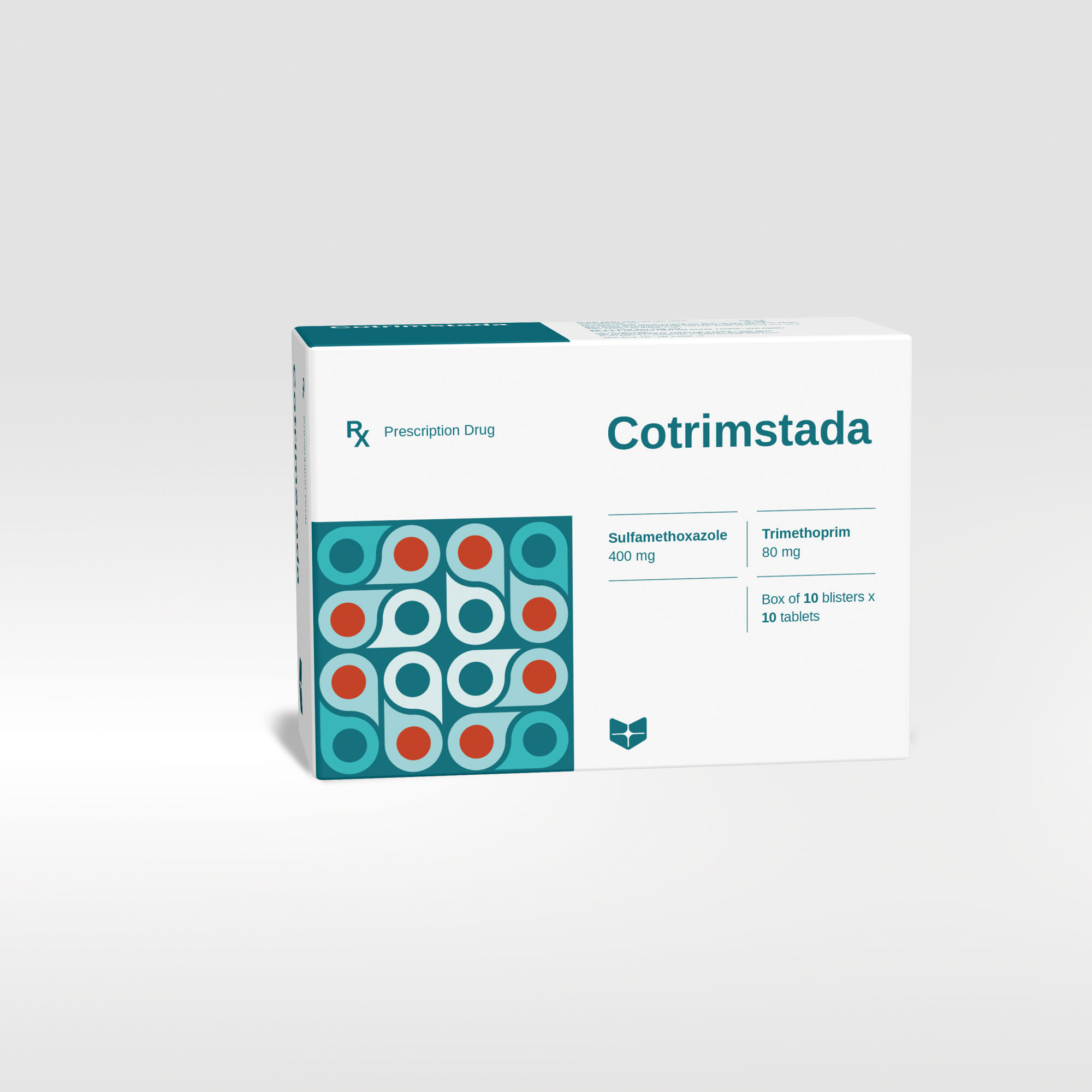Indications
Cotrimoxazole 400/80 tablets are indicated in children (12 – 18 years old) and adults (above 18 years old) for the treatment of the following infections when owing to sensitive organisms:
- Treatment and prevention of Pneumocystis jirovecii pneumonitis or “PJP”.
- Treatment and prophylaxis of toxoplasmosis.
- Treatment of nocardiosis.
The following infections may be treated with Cotrimoxazole where there is bacterial evidence of sensitivity to Cotrimoxazole and good reason to prefer the combination of antibiotics in Cotrimoxazole to a single antibiotic:
- Acute uncomplicated urinary tract infection.
- Acute otitis media.
- Acute exacerbation of chronic bronchitis.
Dosage:
Standard dosage recommendations for acute infections:
- Adults (above 18 years old):
2 tablets every 12 hours.
- Children (12 – 18 years old):
The standard dosage for children is equivalent to approximately 6 mg trimethoprim and 30 mg sulfamethoxazole per kg body weight per day, given in two equally divided doses. Two tablets every 12 hours.
Treatment should be continued until the patient has been symptom free for two days; the majority will require treatment for at least 5 days. If clinical improvement is not evident after 7 days therapy, the patient should be reassessed.
As an alternative to standard dosage for acute uncomplicated lower urinary tract infections, short-term therapy of 1 to 3 days duration has been shown to be effective.
- Elderly patients:
See Special warnings and precautions for use. Unless otherwise specified standard dosage applies.
- Impaired hepatic function:
No data are available relating to dosage in patients with impaired hepatic function.
- Impaired renal function in children (12 – 18 years old) and adults (> 18 years old):
Creatinine clearance > 30 ml/min: Recommended dose is 2 tablets every 12 hours.
Creatinine clearance 15 – 30 ml/min: Recommended dose is 1 tablet every 12 hours.
Creatinine clearance < 15 ml/min: Not recommended.
Measurements of plasma concentration of sulfamethoxazole at intervals of 2 to 3 days are recommended in samples obtained 12 hours after administration of Cotrimoxazole. If the concentration of total sulfamethoxazole exceeds 150 microgram/ml then treatment should be interrupted until the value falls below 120 microgram/ml.
Pneumocystis jirovecii pneumonitis:
- Treatment – children (12 – 18 years old) and adults (> 18 years old):
A higher dosage is recommended, using 20 mg trimethoprim and 100 mg sulfamethoxazole per kg of body weight per day in two or more divided doses for two weeks. The aim is to obtain peak plasma or serum levels of trimethoprim of greater than or equal to 5 microgram/ml (verified in patients receiving 1-hour infusions of intravenous Cotrimoxazole).
- Prevention – Adults (> 18 years old):
The following dose schedules may be used:
2 tablets daily 7 days per week.
2 tablets three times per week on alternative days.
4 tablets per day in two divided doses three times per week on alternative days.
- Prevention – Children (12 – 18 years old):
The standard dosage for children is equivalent to approximately 6 mg trimethoprim and 30 mg sulfamethoxazole per kg body weight per day, given in two equally divided doses.
The following dose schedules may be used for the duration of the period at risk:
2 tablets every 12 hours, seven days per week.
2 tablets every 12 hours, three times per week on alternative days.
2 tablets every 12 hours, three times per week on consecutive days.
4 tablets once a day, three times per week on consecutive days.
The daily dose given on a treatment day approximates to 150 mg trimethoprim/m2/day and 750 mg sulfamethoxazole/m2/day. The total daily dose should not exceed 320 mg trimethoprim and 1600 mg sulfamethoxazole.
Nocardiosis – Adults (> 18 years old):
There is no consensus on the most appropriate dosage. Adult doses of 6 to 8 tablets daily for up to 3 months have been used.
Toxoplasmosis:
There is no consensus on the most appropriate dosage for the treatment or prophylaxis of this condition. The decision should be based on clinical experience. For prophylaxis, however, the dosages suggested for prevention of Pneumocystis jirovecii pneumonitis may be appropriate.
Usage
Cotrimoxazole 400/80 is administered orally with some food or drink.




















